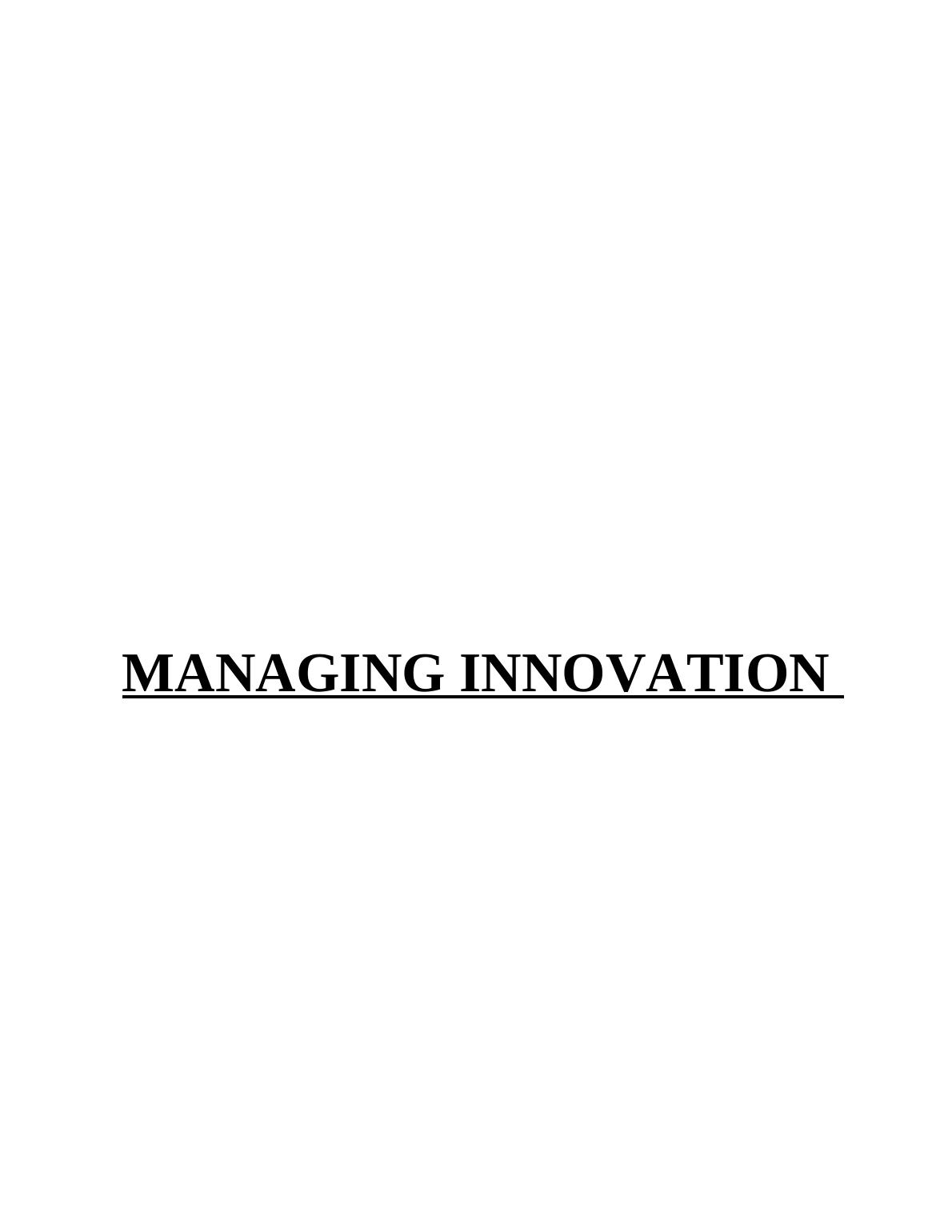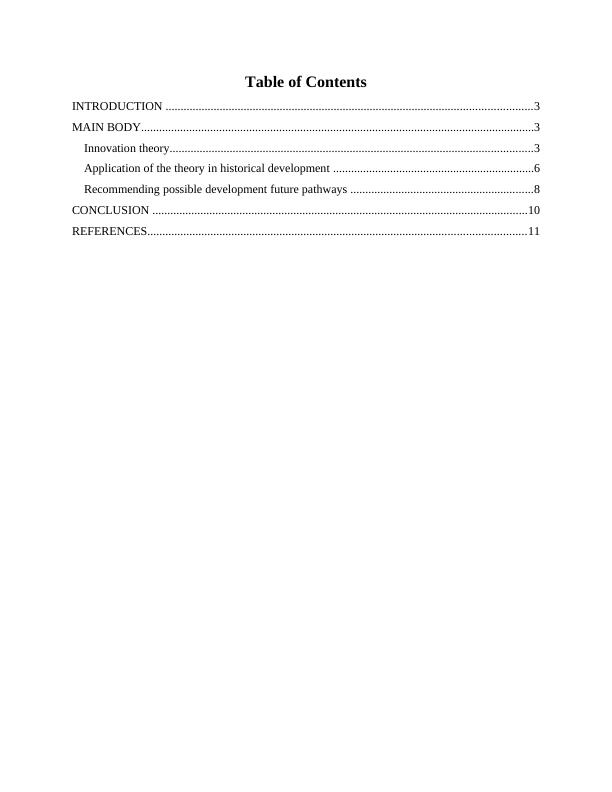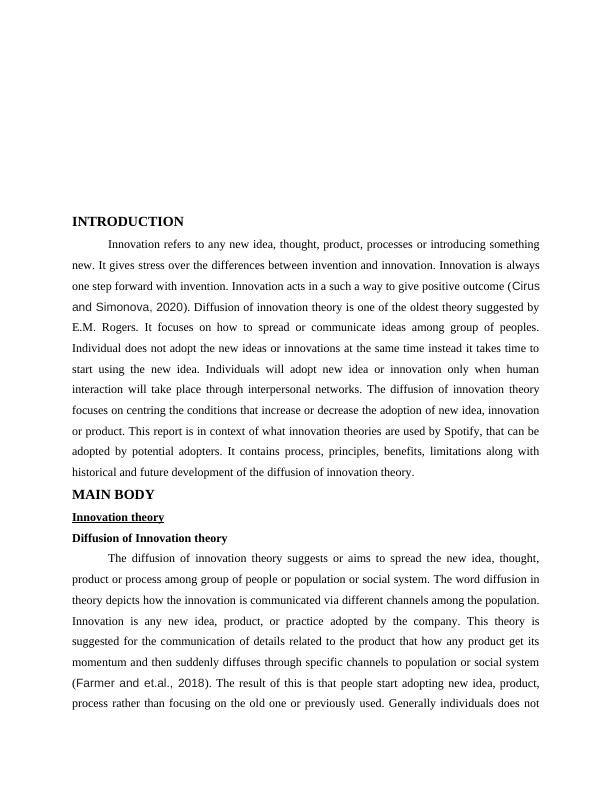Managing Innovation
Added on 2022-12-30
11 Pages3592 Words33 Views
MANAGING INNOVATION

Table of Contents
INTRODUCTION ..........................................................................................................................3
MAIN BODY...................................................................................................................................3
Innovation theory.........................................................................................................................3
Application of the theory in historical development ...................................................................6
Recommending possible development future pathways .............................................................8
CONCLUSION .............................................................................................................................10
REFERENCES..............................................................................................................................11
INTRODUCTION ..........................................................................................................................3
MAIN BODY...................................................................................................................................3
Innovation theory.........................................................................................................................3
Application of the theory in historical development ...................................................................6
Recommending possible development future pathways .............................................................8
CONCLUSION .............................................................................................................................10
REFERENCES..............................................................................................................................11

INTRODUCTION
Innovation refers to any new idea, thought, product, processes or introducing something
new. It gives stress over the differences between invention and innovation. Innovation is always
one step forward with invention. Innovation acts in a such a way to give positive outcome (Cirus
and Simonova, 2020). Diffusion of innovation theory is one of the oldest theory suggested by
E.M. Rogers. It focuses on how to spread or communicate ideas among group of peoples.
Individual does not adopt the new ideas or innovations at the same time instead it takes time to
start using the new idea. Individuals will adopt new idea or innovation only when human
interaction will take place through interpersonal networks. The diffusion of innovation theory
focuses on centring the conditions that increase or decrease the adoption of new idea, innovation
or product. This report is in context of what innovation theories are used by Spotify, that can be
adopted by potential adopters. It contains process, principles, benefits, limitations along with
historical and future development of the diffusion of innovation theory.
MAIN BODY
Innovation theory
Diffusion of Innovation theory
The diffusion of innovation theory suggests or aims to spread the new idea, thought,
product or process among group of people or population or social system. The word diffusion in
theory depicts how the innovation is communicated via different channels among the population.
Innovation is any new idea, product, or practice adopted by the company. This theory is
suggested for the communication of details related to the product that how any product get its
momentum and then suddenly diffuses through specific channels to population or social system
(Farmer and et.al., 2018). The result of this is that people start adopting new idea, product,
process rather than focusing on the old one or previously used. Generally individuals does not
Innovation refers to any new idea, thought, product, processes or introducing something
new. It gives stress over the differences between invention and innovation. Innovation is always
one step forward with invention. Innovation acts in a such a way to give positive outcome (Cirus
and Simonova, 2020). Diffusion of innovation theory is one of the oldest theory suggested by
E.M. Rogers. It focuses on how to spread or communicate ideas among group of peoples.
Individual does not adopt the new ideas or innovations at the same time instead it takes time to
start using the new idea. Individuals will adopt new idea or innovation only when human
interaction will take place through interpersonal networks. The diffusion of innovation theory
focuses on centring the conditions that increase or decrease the adoption of new idea, innovation
or product. This report is in context of what innovation theories are used by Spotify, that can be
adopted by potential adopters. It contains process, principles, benefits, limitations along with
historical and future development of the diffusion of innovation theory.
MAIN BODY
Innovation theory
Diffusion of Innovation theory
The diffusion of innovation theory suggests or aims to spread the new idea, thought,
product or process among group of people or population or social system. The word diffusion in
theory depicts how the innovation is communicated via different channels among the population.
Innovation is any new idea, product, or practice adopted by the company. This theory is
suggested for the communication of details related to the product that how any product get its
momentum and then suddenly diffuses through specific channels to population or social system
(Farmer and et.al., 2018). The result of this is that people start adopting new idea, product,
process rather than focusing on the old one or previously used. Generally individuals does not

adopt the new ideas or innovation easily and the individuals who adopt idea at early stage have
different characteristics. While spreading the information related to the innovation or idea, it is
necessary to know the characteristics of the target population.
The five adopter categories of the theory are as follows:
Innovators- Innovators are the individuals who use or tries the innovation for the first time, or
they are the people who want to be the first for trying the innovation. These people are
adventurous and always willing to take risk, they try new ideas and from them develops new
ideas or thoughts. The innovators have features like they are adventurous, venturesome, willing
to take risks, daring (Kahn, 2018). Very little strategy is required to appeal this category of
people. They play an important role in the introduction of innovation and are very quick to
accept the ideas, thoughts and innovations.
Early adopters- The early adopters are represented as a leader. They always know that there is
need to change the idea and are very much comfortable in adopting the new ideas. The early
adopters do not require any information or convincing factor which convinces them to change.
The strategies used to appeal this population is done by providing them manuals and information
sheets. They are the most respected individual in the whole system which advices information
about the innovation to others.
Early Majority- This category includes individuals who adopt new idea before the average
person adopts. They require various evidences in relation with the innovation, if it is working or
not before adopting the new idea. The strategies to appeal this group of individual is to provide
them with success stories and evidences. They act as a link between very early adopters and late
adopters.
Late Majority- This category involves individuals who are doubtful in adopting the new idea.
They adopt the new idea only when the majority of people have used or started working on it.
Strategies to appeal this group of individual is to provide information of the people who have
used the idea or innovation and adopted it successfully (QaziRaza and Shah, 2018). They
adopt innovation just in peer pressure and not by motivation of adoption.
Laggards- This category involves people who are conservative and follows tradition strictly.
They are very doubtful and fearful of change. They are hard to convince to adopt the innovation.
The strategies to convince or appeal these type of individuals is to give fear appeals and pressure
different characteristics. While spreading the information related to the innovation or idea, it is
necessary to know the characteristics of the target population.
The five adopter categories of the theory are as follows:
Innovators- Innovators are the individuals who use or tries the innovation for the first time, or
they are the people who want to be the first for trying the innovation. These people are
adventurous and always willing to take risk, they try new ideas and from them develops new
ideas or thoughts. The innovators have features like they are adventurous, venturesome, willing
to take risks, daring (Kahn, 2018). Very little strategy is required to appeal this category of
people. They play an important role in the introduction of innovation and are very quick to
accept the ideas, thoughts and innovations.
Early adopters- The early adopters are represented as a leader. They always know that there is
need to change the idea and are very much comfortable in adopting the new ideas. The early
adopters do not require any information or convincing factor which convinces them to change.
The strategies used to appeal this population is done by providing them manuals and information
sheets. They are the most respected individual in the whole system which advices information
about the innovation to others.
Early Majority- This category includes individuals who adopt new idea before the average
person adopts. They require various evidences in relation with the innovation, if it is working or
not before adopting the new idea. The strategies to appeal this group of individual is to provide
them with success stories and evidences. They act as a link between very early adopters and late
adopters.
Late Majority- This category involves individuals who are doubtful in adopting the new idea.
They adopt the new idea only when the majority of people have used or started working on it.
Strategies to appeal this group of individual is to provide information of the people who have
used the idea or innovation and adopted it successfully (QaziRaza and Shah, 2018). They
adopt innovation just in peer pressure and not by motivation of adoption.
Laggards- This category involves people who are conservative and follows tradition strictly.
They are very doubtful and fearful of change. They are hard to convince to adopt the innovation.
The strategies to convince or appeal these type of individuals is to give fear appeals and pressure

End of preview
Want to access all the pages? Upload your documents or become a member.
Related Documents
Managing Innovation: Diffusion of Innovation Theory and its Application in BrewDoglg...
|11
|3414
|28
Managing Innovationlg...
|20
|3984
|51
Innovation Management of Teslalg...
|12
|3909
|431
Diffusion of Innovationlg...
|6
|1423
|330
Managing Innovation: Theories, Application, and Future Developmentlg...
|12
|3865
|21
Managing Innovation Assessmentlg...
|12
|3834
|173
